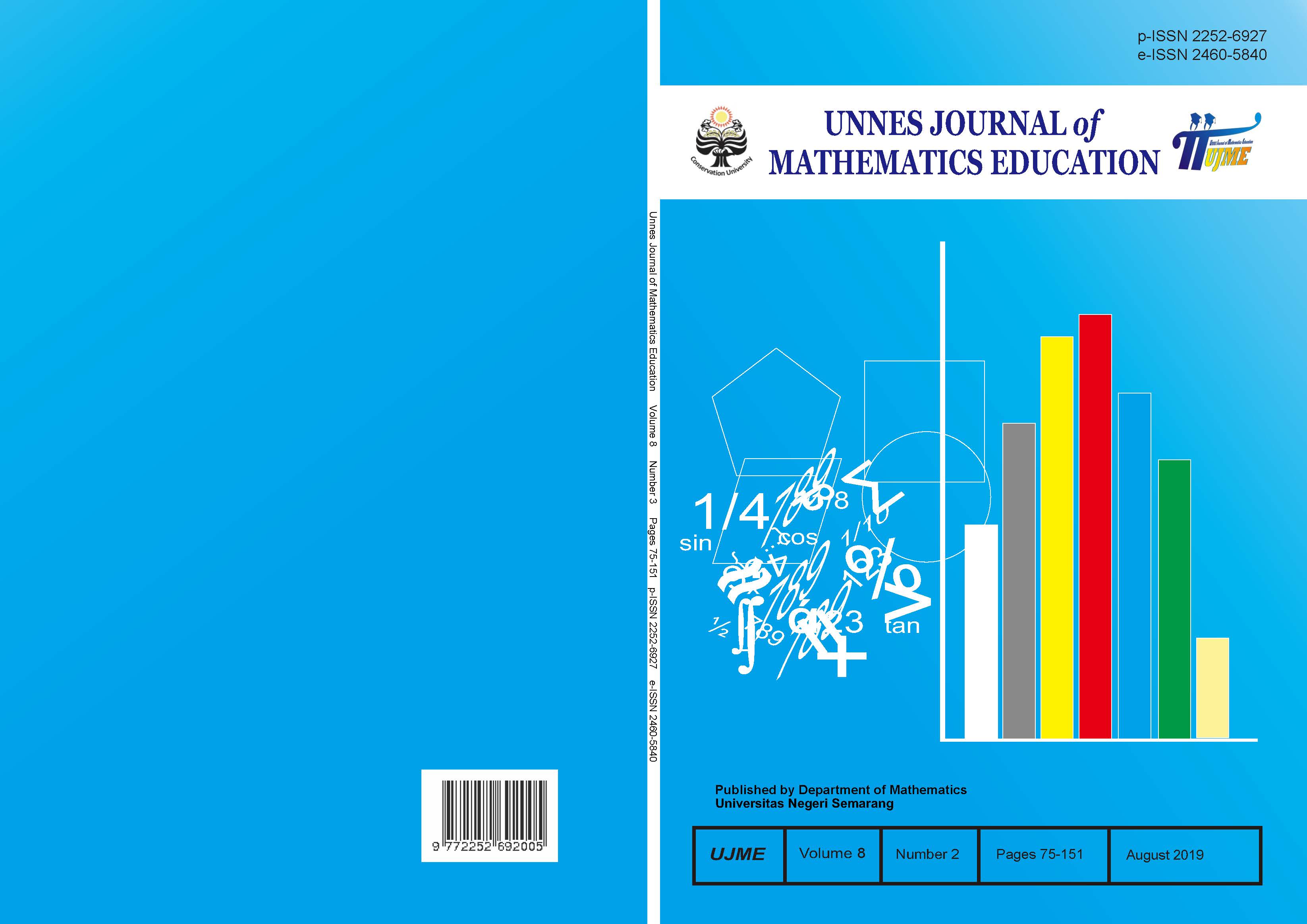Mathematical communication ability of 7th grade students viewed from indonesian language ability in experiential learning model
##plugins.themes.academic_pro.article.main##
Abstract
Communication ability need to be improved so that students can solve math problems well. This study aims to determine 1) the completeness of learning mathematics communication 7th grade students with experiential learning models; 2) the influence of Indonesian language ability on mathematical communication ability; 3) mathematical communication ability of students who have very high Indonesian language ability; 4) mathematical communication ability of students who have high Indonesian language ability; 5) mathematical communication ability of students who have medium Indonesian language ability. This study uses a combination method. The population in this study is 7th grade students in one of the junior high schools in the city of Semarang year 2018/2019. Sampling by random sampling technique and subject selection with purposive sampling technique. The results show that (1) mathematical communication ability of 7th grade students with experiential learning models can achieve learning completeness; (2) there is an influence of Indonesian language ability on students' mathematical communication ability in the experiential learning model; (3) students with very high Indonesian language ability have been able to reach all indicators of written communication ability; (4) students with high Indonesian language ability have been able to reach all indicators of written mathematical communication ability even though there are still errors in making conclusions; (5) students with medium Indonesian language ability are only able to master two indicator of written mathematical communication ability.
##plugins.themes.academic_pro.article.details##
References
Fujiati, I. & Mastur, Z. (2014). Keefektifan Model Pogil Berbantuan Alat Peraga Berbasis Etnomatematika terhadap Kemampuaan Komunikasi Matematis. UJME, Unnes Journal of Mathematics Education, 3(3): 175-180. Retrieved from https://journal.unnes.ac.id/-sju/index.php/ujme/article/view/4482
Government Regulation in Indonesia Number 32, 2013.
Inprasitha, M., Pattanajak, A., & Inprasitha, N. (2012). A Study of Student’s Mathematical Communication in Teacher Professional Development. Journal of Modern Education Review. Thailand: Universitas Khon Kaen. 2(1): 38-46. Retrieved from https://papers-.ssrn.com/sol3/papers.cfm?abstract_id=2096898
Kolb, A. Y & Kolb, D. A. (2008). Experiential learning Teory : A Dynamic, Holistic Approach to Managemen Learning, Education and Development. In Handbook of Management Learning, Education and Development. Edited by Armstrong, S. J. & Fukami. London: Sage Publications.
Kusuma, Y. A, & Masriyah. (2014). Penerapan Model Experiental Learning Pada Materi Luas dan Keliling Persegipanjang di Kelas VII-I Smp Negeri 22 Surabaya. Jurnal Ilmiah Pendidikan Matematika, 3(3): 274-280. Retrieved from http://jurnalmahasiswa.unesa.ac.id/index.php/mathedunesa/article/view/12958
Law of The Republic of Indonesia Number 20, 2003.
Mahendra, I.W.E. (2017). Project Based Learning Bermuatan Etnomatematika dalam Pembelajar Matematika. JPI (Jurnal Pendidikan Indonesia), 6(1): 106-114. Retrieved from https://doi.org/10.23887/jpi-undiksha.v6i1.9257
Mahmudi, A. (2009). Komunikasi dalam Pembelajaran Matematika. Jurnal MIPMIPA UNHALU, 8(1): 1-9. Retrieved from http://staffnew.uny.ac.id/upload/132240454/penelitian/Makalah+06+Jurnal+UNHALU+2008+_Komunikasi+dlm+Pembelajaran+Matematika_.pdf
Mutmainah, N. L, Sardulo G., & Davi, A. (2016). Profil Komunikasi Matematis Siswa Sekolah Menengah Pertama dalam Memecahkan Masalah Matematika Ditinjau dari Kecerdasan Linguistik. Jurnal LPPM, 4(2). Retrieved from http://e-journal.unipma.ac.id/index.php/JP-LPPM/article/view/430/401
NCTM. (2000). Principles and Standards for School Mathematics. RestonVA: The National Council of Teachers of Mathematics, Inc.
OECD. (2018). PISA 2015: PISA Result in Fokus. Retrieved from http://www.oecd.org/
Paridjo, B. W. (2017). Analysis Mathematical Communication Skils Students In the Matter Algebra Based Nctm. IOSR Journal of Mathematics, 13(1): 60-66. Retrieved from http://www.iosrjournals.org/iosr-jm/papers/-Vol13-issue1/Version-5/I1301056066.pdf
Permata, C.P., Kartono., & Sunarmi. (2015). Analisis Kemampuan Komunikasi Matematis Siswa Kelas VIII SMP pada Model Pembelajaran TSTS dengan Pendekatan Saintifik. Unnes Journal of Mathematics Education, 4(2): 127-133. Retrieved from https://journal.unnes.ac.id/sju/index.php/ujme/article/view/7452
Prayitno, S., St. Suwarsono & Tatag Yuli E. S. (2013). Komunikasi Matematis Siswa Smp dalam Menyelesaikan Soal Matematika Berjenjang Ditinjau dari Perbedaan Gender. Makalah dipresentasikan pada Seminar Nasional Matematika dan Pendidikan Matematika, Jurusan Pendidikan Matematika FMIPA UNY, 9 November 2013.
Qohar, A. (2010). Mengembangkan Kemampuan Pemahaman, Koneksi, dan Komunikasi Matematis serta Kemandirian Belajar Matematis Siswa SMP Melalui Reciprocal Teaching. Tesis. Bandung: PPS Univesitas Pendidikan Indonesia.
Shadiq, F. (2007). Laporan Hasil Seminar dan Lokakarya Pembelajaran Matematika 15-16 Maret 2007. Yogyakarta: Depdiknas, P4TK Matematika Yogyakarta.
Sumarmo, U. (2014). Asesmen Soft Skill dan Hard Skill Matematik Siswa dalam Kurikulum Matematika. Makalah dipresentasikan pada Seminar Pendidikan Matematika, Sekolah Tinggi Islam Negeri Batusangkar, 14 September.
TIMSS. (2016). Highlights From TIMSS and TIMSS Advanced 2015: Mathematics and Science Achievement of U.S. Students in Grades 4 and 8 and in Advanced Courses at the End of High School in an International Context Washington, DC: U. S. Department of Education. Retrieved from http://nces.ed.gov/-pubsearch.
Wijarani, D. (2016). Pengaruh Kemampuan Membaca Pemahaman terhadap Prestasi Belajar Matematika Siswa Kelas VII Sekolah Menengah Pertama Negeri Di Kecamatan Kebumen Tahun Pelajaran 2015/2016. Skripsi. Purworejo: FKIP Universitas Muhammadiyah Purworejo.
